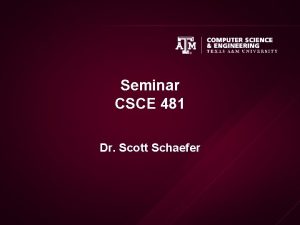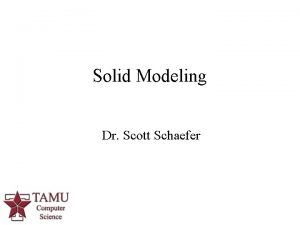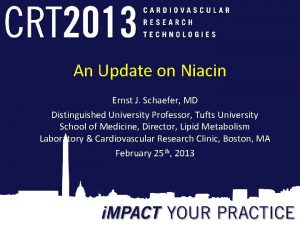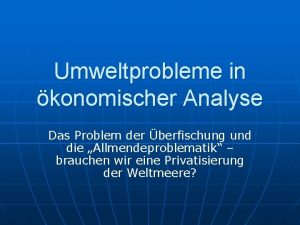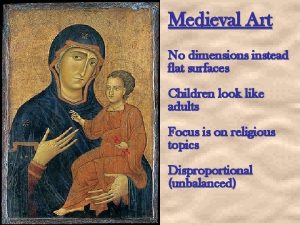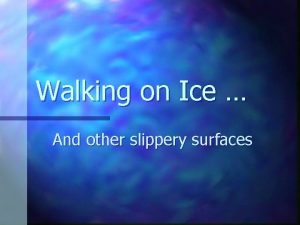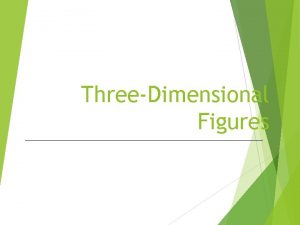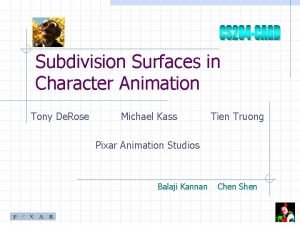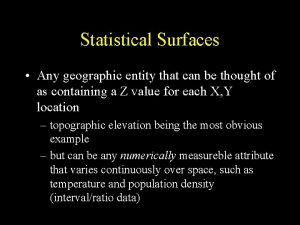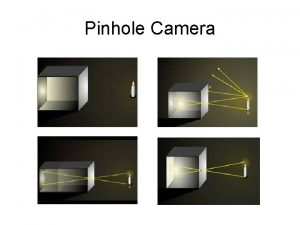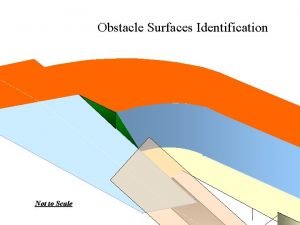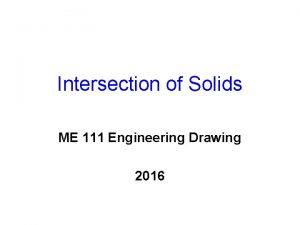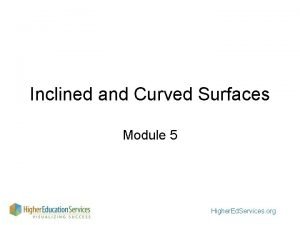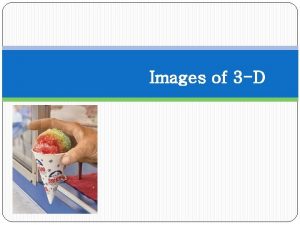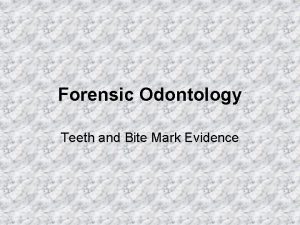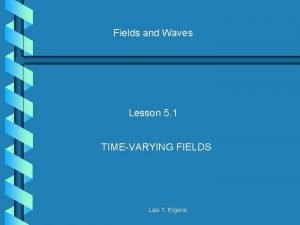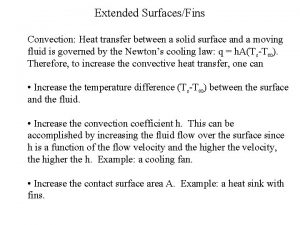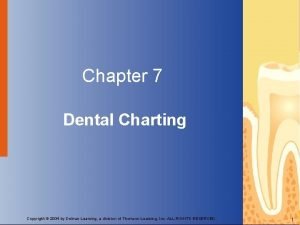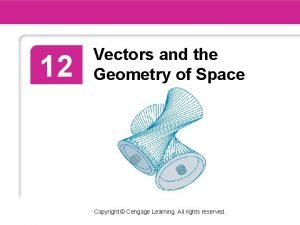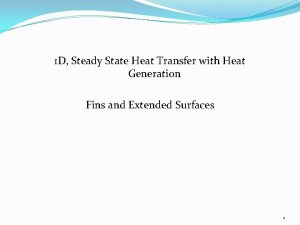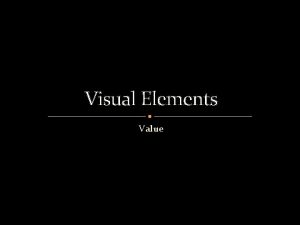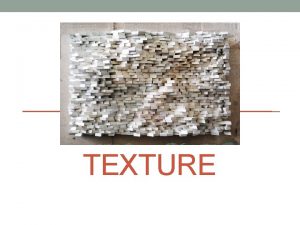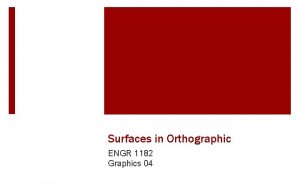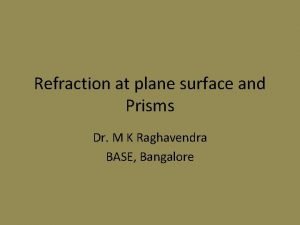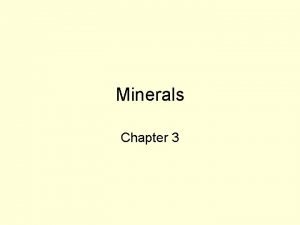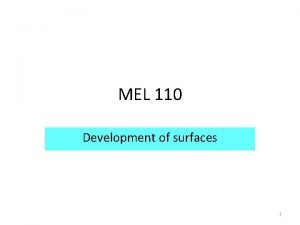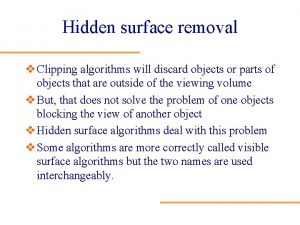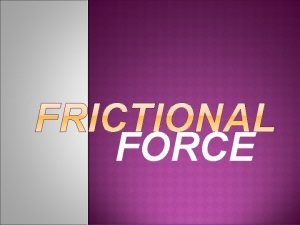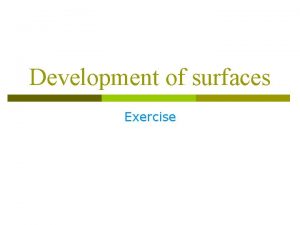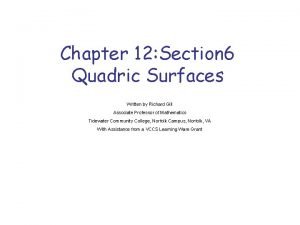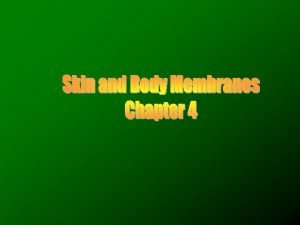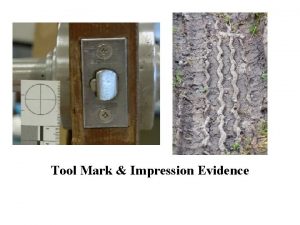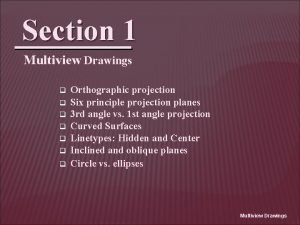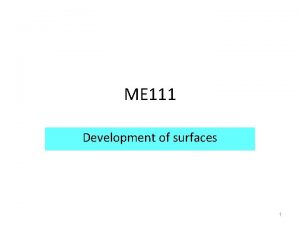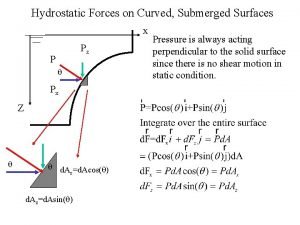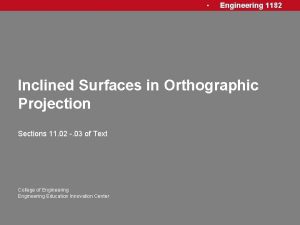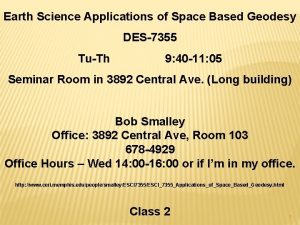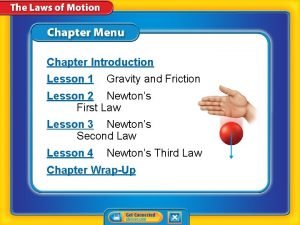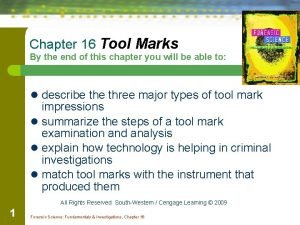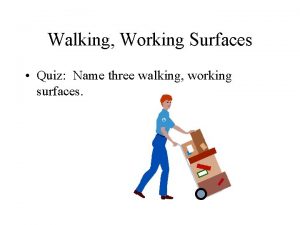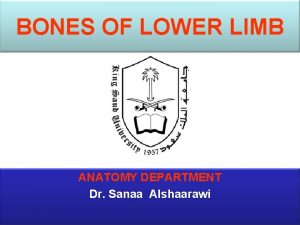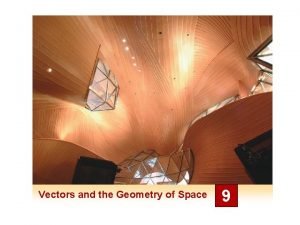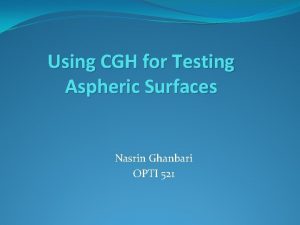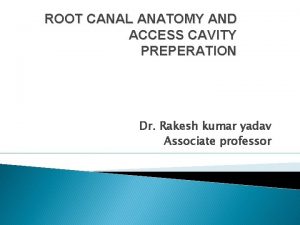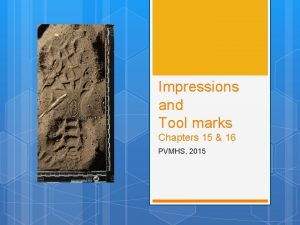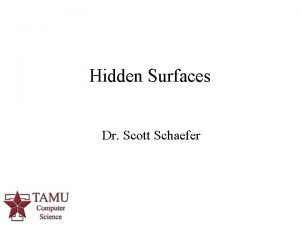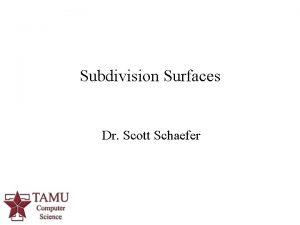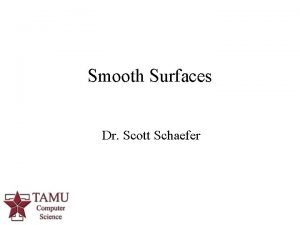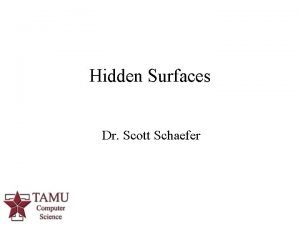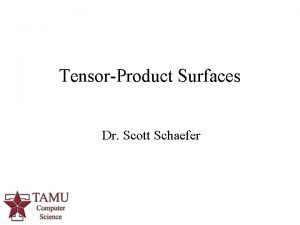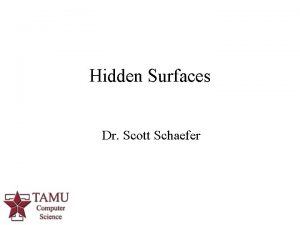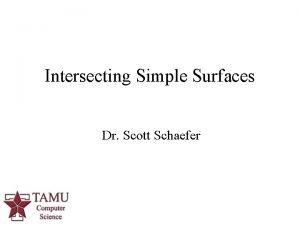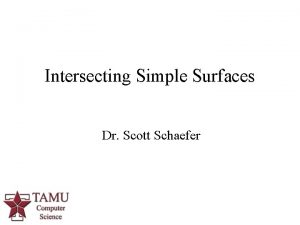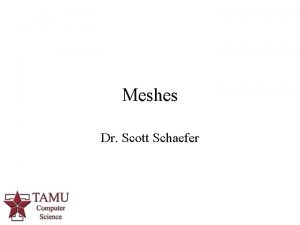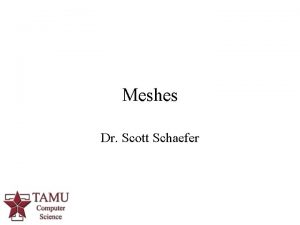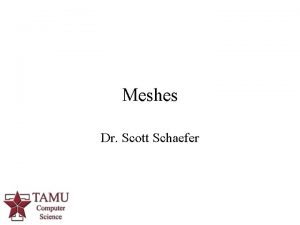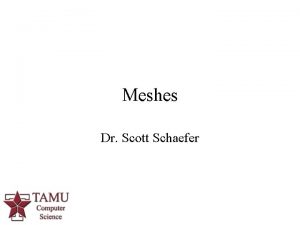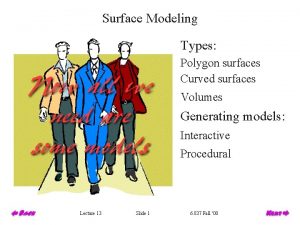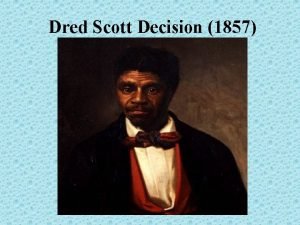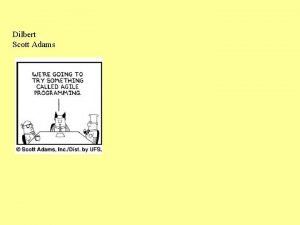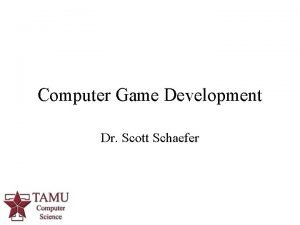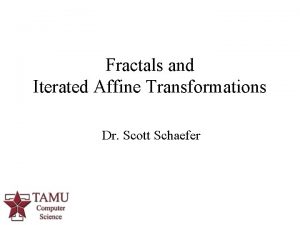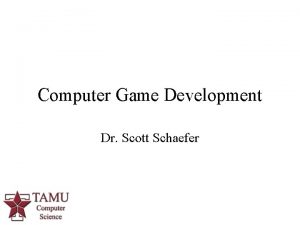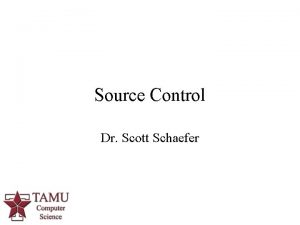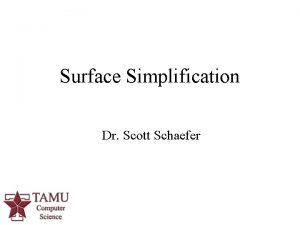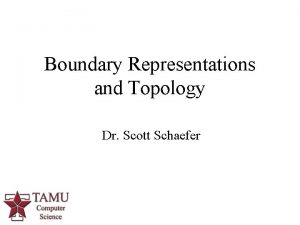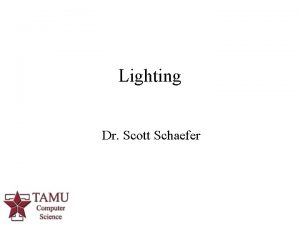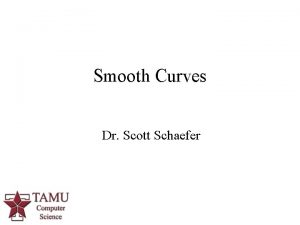Surfaces Dr Scott Schaefer 1 Types of Surfaces



























































- Slides: 59

Surfaces Dr. Scott Schaefer 1

Types of Surfaces Implicit Surfaces n Parametric Surfaces n Deformed Surfaces n 2/59

Implicit Surfaces 3/59

Implicit Surfaces 4/59

Implicit Surfaces n Examples u Spheres u Planes u Cylinders u Cones u Tori 5/59

Intersecting Implicit Surfaces 6/59

Intersecting Implicit Surfaces 7/59

Intersecting Implicit Surfaces n Example u u 8/59

Intersecting Implicit Surfaces n Example u u 9/59

Intersecting Implicit Surfaces n Example u u 10/59

Intersecting Implicit Surfaces n Example u u 11/59

Normals of Implicit Surfaces n Given F(x, y, z)=0, find the normal at a point (x, y, z) 12/59

Normals of Implicit Surfaces Given F(x, y, z)=0, find the normal at a point (x, y, z) n Assume we have a parametric curve (x(t), y(t), z(t)) on the surface of F(x, y, z) n 13/59

Normals of Implicit Surfaces Given F(x, y, z)=0, find the normal at a point (x, y, z) n Assume we have a parametric curve (x(t), y(t), z(t)) on the surface of F(x, y, z) n F(x(t), y(t), z(t))=0 n 14/59

Normals of Implicit Surfaces Given F(x, y, z)=0, find the normal at a point (x, y, z) n Assume we have a parametric curve (x(t), y(t), z(t)) on the surface of F(x, y, z) n F(x(t), y(t), z(t))=0 n 15/59

Normals of Implicit Surfaces Given F(x, y, z)=0, find the normal at a point (x, y, z) n Assume we have a parametric curve (x(t), y(t), z(t)) on the surface of F(x, y, z) n F(x(t), y(t), z(t))=0 n 16/59

Normals of Implicit Surfaces Given F(x, y, z)=0, find the normal at a point (x, y, z) n Assume we have a parametric curve (x(t), y(t), z(t)) on the surface of F(x, y, z) n F(x(t), y(t), z(t))=0 n 17/59

Normals of Implicit Surfaces Given F(x, y, z)=0, find the normal at a point (x, y, z) n Assume we have a parametric curve (x(t), y(t), z(t)) on the surface of F(x, y, z) n F(x(t), y(t), z(t))=0 n Tangent of curve!!! 18/59

Normals of Implicit Surfaces Given F(x, y, z)=0, find the normal at a point (x, y, z) n Assume we have a parametric curve (x(t), y(t), z(t)) on the surface of F(x, y, z) n F(x(t), y(t), z(t))=0 n Normal of surface!!! 19/59

Normals of Implicit Surfaces n Example 20/59

Normals of Implicit Surfaces n Example 21/59

Normals of Implicit Surfaces n Example 22/59

Implicit Surfaces Advantages u Easy to determine inside/outside u Easy to determine if a point is on the surface n Disadvantages u Hard to generate points on the surface n 23/59

Parametric Surfaces Geri’s Game Copyright Pixar 24/59

Parametric Surfaces 25/59

Parametric Surfaces 26/59

Intersecting Parametric Surfaces Solve three equations (one for each of x, y, z) for the parameters t, u, v n Plug parameters back into equation to find actual intersection n 27/59

Intersecting Parametric Surfaces 28/59

Intersecting Parametric Surfaces 29/59

Intersecting Parametric Surfaces 30/59

Intersecting Parametric Surfaces 31/59

Normals of Parametric Surfaces n Assume t is fixed 32/59

Normals of Parametric Surfaces n Assume t is fixed Curve on surface 33/59

Normals of Parametric Surfaces n Assume t is fixed Tangent at s 34/59

Normals of Parametric Surfaces n Assume s is fixed 35/59

Normals of Parametric Surfaces n Assume s is fixed Curve on surface 36/59

Normals of Parametric Surfaces n Assume s is fixed Tangent at t 37/59

Normals of Parametric Surfaces n Normal at s, t is 38/59

Parametric Surfaces Advantages u Easy to generate points on the surface n Disadvantages u Hard to determine inside/outside u Hard to determine if a point is on the surface n 39/59

Deformed Surfaces Assume we have some surface S and a deformation function D(x, y, z) n D(S) is deformed surface n n Useful for creating complicated shapes from simple objects 40/59

Intersecting Deformed Surfaces Assume D(x, y, z) is simple… a matrix n First deform line L(t) by inverse of D n Calculate intersection with undeformed surface S n Transform intersection point and normal by D n 41/59

Intersecting Deformed Surfaces n Example 42/59

Intersecting Deformed Surfaces n Example 43/59

Intersecting Deformed Surfaces n Example 44/59

Intersecting Deformed Surfaces n Example 45/59

Intersecting Deformed Surfaces n Example 46/59

Intersecting Deformed Surfaces n Example 47/59

Normals of Deformed Surfaces Define how tangents transform first n Assume curve C(t) on surface n 48/59

Normals of Deformed Surfaces Define how tangents transform first n Assume curve C(t) on surface n 49/59

Normals of Deformed Surfaces Define how tangents transform first n Assume curve C(t) on surface n Tangents transform by just applying the deformation D!!! 50/59

Normals of Deformed Surfaces n Normals and tangents are orthogonal before and after deformation 51/59

Normals of Deformed Surfaces n Normals and tangents are orthogonal before and after deformation 52/59

Normals of Deformed Surfaces n Normals and tangents are orthogonal before and after deformation 53/59

Normals of Deformed Surfaces n Normals and tangents are orthogonal before and after deformation 54/59

Normals of Deformed Surfaces n Normals and tangents are orthogonal before and after deformation 55/59

Normals of Deformed Surfaces n Example 56/59

Normals of Deformed Surfaces n Example 57/59

Normals of Deformed Surfaces n Example 58/59

Deformed Surfaces Advantages u Simple surfaces can represent complex shapes u Affine transformations yield simple calculations n Disadvantages u Complicated deformation functions can be difficult to use (inverse may not exist!!!) n 59/59
 Csce 481 tamu
Csce 481 tamu Scott schaefer tamu
Scott schaefer tamu Moos and schaefer 1984 crisis theory
Moos and schaefer 1984 crisis theory Schaefer model
Schaefer model Nachgestellte titel beistrich
Nachgestellte titel beistrich Ernst schaefer md
Ernst schaefer md Analyse
Analyse Kathy_schaefer
Kathy_schaefer Piero della francesca
Piero della francesca Rolf schaefer kanzlei für arbeitsrecht hannover
Rolf schaefer kanzlei für arbeitsrecht hannover Walking on slippery surfaces
Walking on slippery surfaces How many edges does a cone have
How many edges does a cone have Subdivision surfaces in character animation
Subdivision surfaces in character animation In discrete statistical surfaces the z values occur
In discrete statistical surfaces the z values occur Reflection at plane surfaces
Reflection at plane surfaces Human heart border
Human heart border Outer horizontal surface
Outer horizontal surface Interpenetration of solids examples
Interpenetration of solids examples Orthographic projection of curved surfaces
Orthographic projection of curved surfaces All prisms
All prisms Ted bundys teeth
Ted bundys teeth Imaginary surfaces
Imaginary surfaces Heat transfer from extended surfaces fins
Heat transfer from extended surfaces fins A rectangular prism has 6 faces 8 edges and 10 vertices
A rectangular prism has 6 faces 8 edges and 10 vertices Geometric charting dental
Geometric charting dental Quadric surfaces chart
Quadric surfaces chart Cylinder heat transfer
Cylinder heat transfer The relative lightness and darkness of surfaces.
The relative lightness and darkness of surfaces. ____ refers to the tactile qualities of surfaces
____ refers to the tactile qualities of surfaces Orthographic projection inclined surfaces
Orthographic projection inclined surfaces Magic wall interactive surfaces market segments
Magic wall interactive surfaces market segments The refractive indices of crown glass prism for c d f
The refractive indices of crown glass prism for c d f The splitting of a mineral along smooth flat surfaces
The splitting of a mineral along smooth flat surfaces Development of lateral surfaces
Development of lateral surfaces Hidden surface removal algorithm
Hidden surface removal algorithm Friction
Friction Development of surfaces
Development of surfaces Senile caries meaning
Senile caries meaning Yz plane equation
Yz plane equation Lines body cavities
Lines body cavities Patent impressions
Patent impressions Normal inclined and oblique surfaces
Normal inclined and oblique surfaces Pooja nuti
Pooja nuti Development of surfaces
Development of surfaces Hydrostatic forces on submerged surfaces
Hydrostatic forces on submerged surfaces Inclined surfaces in orthographic projections
Inclined surfaces in orthographic projections Ellispsoid
Ellispsoid Gravity and friction lesson 1
Gravity and friction lesson 1 Examples of tool marks
Examples of tool marks Vertical
Vertical Aircraft control surfaces and components
Aircraft control surfaces and components Walking and working surfaces quiz
Walking and working surfaces quiz Walking working surfaces
Walking working surfaces Pituitary hormones and their targets
Pituitary hormones and their targets Interpenetration of surfaces
Interpenetration of surfaces Borders and surfaces of femur
Borders and surfaces of femur Quadratic surfaces
Quadratic surfaces Testing aspheric surfaces
Testing aspheric surfaces Access cavity krasner and rankow
Access cavity krasner and rankow Mark made when surfaces slide across one another:
Mark made when surfaces slide across one another:
